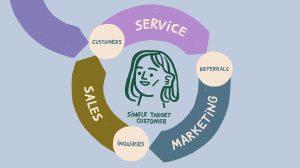Written by Daniela Furtado
How you appear on Google is not random. It’s your personal brand. In this article, I’ll show you how to see, create, and measure personal branding for architects and interior designers online.

Between corporate and personal branding, one isn’t better than the other but the latter is more common in this industry. As the founders, designers often name their firms after themselves, spearhead every project and build close relationships with clients.
Brynne Campbell has also noticed the same.
Over coffee, Brynne told me about her 300-page doctorate dissertation where she studied two architecture firms –
- John B. Parkin and Associates, and
- Arthur Erickson and Associates.
Both firms invested in and practiced marketing. However, while Parkin focused on the team’s image, Erickson put himself in the spotlight as the firm’s spokesperson.
In other words, Erickson created a personal brand.
Personal branding isn’t a foreign concept. You likely already have one. But what value can it really bring to your business? And how do you measure it?
I’d argue Google.
Erickson created his brand in the ’60s, long before Google. But given the technology, I’d like to think he would have used search engines to construct his public image. I see so many architects do it today — and I going to show you how they’re doing it. And how Arthur Erikson probably would’ve done it if he was still alive.
(By the way, I’m speaking about this very topic at the Interior Design Show in January.)
1. Seeing Personal Brands
Let’s search for a local architect like Natasha Lebel on Google.
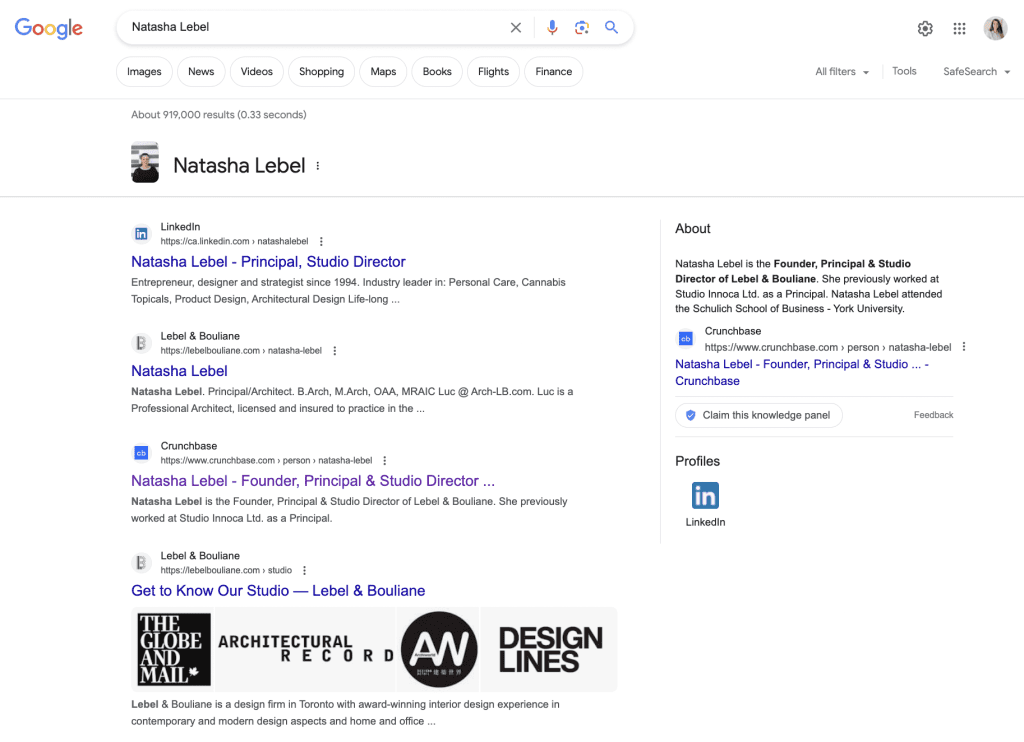
Now let’s look up an acclaimed architect like Eva Franch i Gilabert or Lesley Lokko.
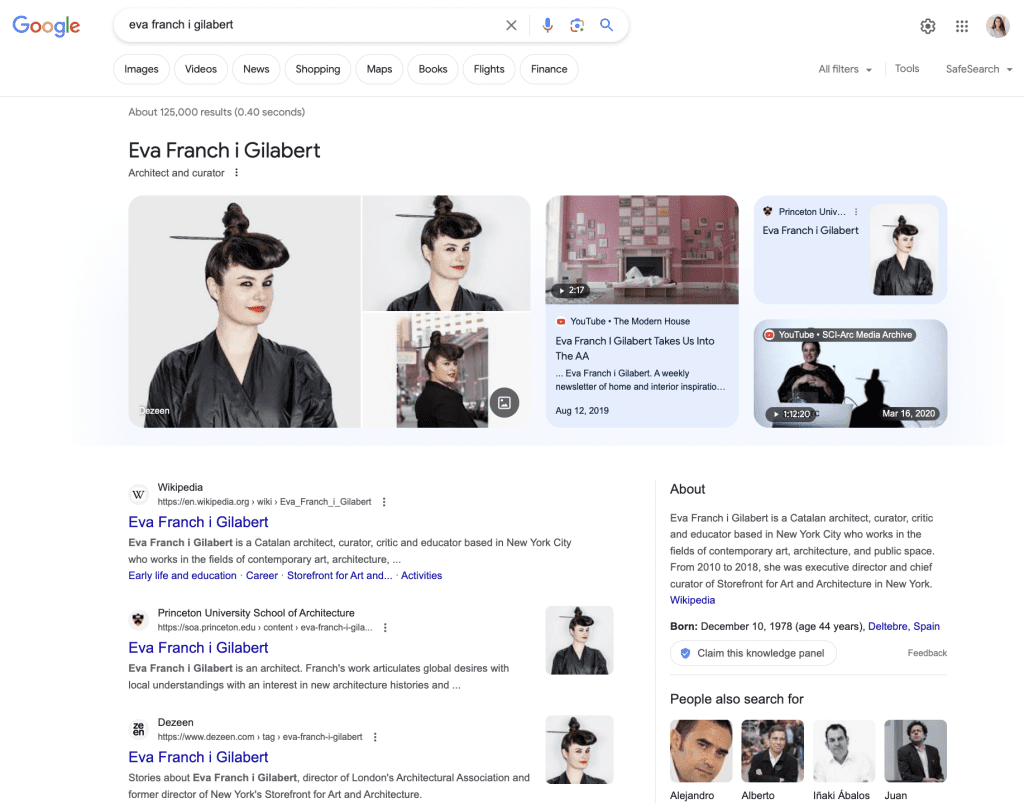
Can you spot the differences?
The search result pages for the more famous architects prominently feature their names and professions. Their headshots beam across the screen, and on the right-hand side, there is a snippet of their biography, birthday, and education.
This section on a search results page is called a Knowledge Panel. And it’s not random. This is what their personal brand looks like. It’s a result of their efforts to demonstrate their expertise and contribute to architecture and society over the years – on social media, through press, books, and videos.
2. Creating Personal Brands
Knowledge Panels don’t appear randomly. You can create them. This process is a form of search engine optimization (SEO). You might think SEO is just the keywords, metadata, and sitemaps you add to your website, but it’s also how you optimize your online presence across the World Wide Web, on websites beyond your own. Similar to Erikson, you can curate your public image online.
These Knowledge Panels used to take a lot of work to attain. You had to have a Wikipedia page, bylines from global media publications, and a book. But Google is changing its algorithm. You don’t have to reach celebrity status for Google to recognize you. Being an expert in your field is enough.
The search engine industry suspects that the future of SEO will revolve around personal brands, influencers, and individuals over corporations. In 2022, Google updated its algorithm to add another “e” (experience) to E-E-A-T. That was a big clue of the new direction. Leaders in the space, like Lily Ray, have also publicly expressed the same observations.
I’ve been studying knowledge panels to find patterns and understand how to recreate them. So far, these are the typical ingredients I see:
- Domain – They have a website domain with their name in it.
- Digital Assets – They have digital assets with their name on them, like a book, TV show, or film.
- Social Media – Historically, Google says socials aren’t a ranking factor, but we’re starting to see a shift. Those with knowledge panels all have social media handles with their name in them.
- Expertise – They regularly speak on the same topic, making them an expert.
- Authority – They create content on their own channels and high-authority ones. They have bylines and features in digital publications, podcasts, or YouTube channels.
3. Measuring Personal Brands
So how do you measure a personal brand’s demand or growth? Simple. With keyword research tools.
Take “Siamak Hariri” as an example.
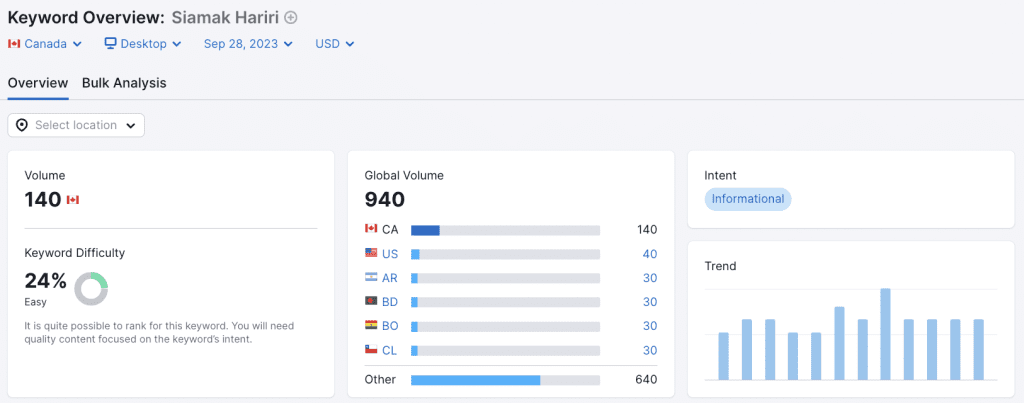
An average of 940 people search his name every month, while 1,500 people search for a generic term like “architect firm Toronto”.
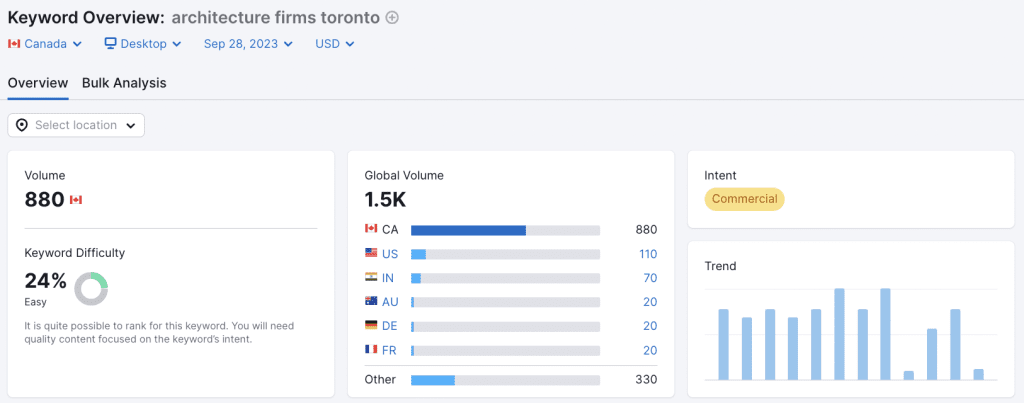
Hariri has created almost just as much demand for himself.
Another way to measure a personal brand for architects and designers, and probably one of the most important, is its impact on your firm’s sales.
In Campbell’s research, she saw a correlation between marketing profitability and overall financial growth. From my experience in the agency, I see branding doesn’t just bring in more revenue, it also brings a degree of ease. Instead of wooing prospective clients, they come to sales calls already believing, respecting and trusting you. Even more primed to pay a premium price tag.
Marketing makes sales easier. So does a strong personal brand. But how do you marry the two? And if you’ve never done it before, where in the world do you start? I’ll write about that next month. Join our newsletter to get notified.
How to Work with Us
We help design-build firms increase website traffic by 5 times and sales inquiries by 3 times. Hire us to train you on our program, or do it all for you.
Check out the five questions to ask yourself before hiring an agency. If you think we’d make a good team, contact us today!
Daniela Furtado
Daniela Furtado is a consultant, writer and speaker on how to make businesses easy to find online. She is the founder and CEO of Findable Digital Marketing. Off the clock, she enjoys cooking, dancing, and drawing. She is based in Toronto, Canada.
 The Good, The Bad and The Ugly of Keyword Data
The Good, The Bad and The Ugly of Keyword Data Our “Secret Sauce” to Choosing Keywords for Designers
Our “Secret Sauce” to Choosing Keywords for Designers The Delicate Dance Between SEO and Creativity
The Delicate Dance Between SEO and Creativity